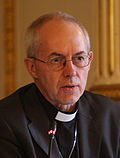Archbishop of Canterbury
| Archbishop of Canterbury | |
|---|---|
| Bishopric | |
| anglican | |

Arms of the Archbishop of Canterbury: Azure, an episcopal staff in pale or, ensigned with a cross pattée argent, surmounted of a pall of the last, edged and fringed of the second charged with four crosses pattée fitchée (pointed) sable
|
|
 |
|
| Incumbent: Justin Welby since 4 February 2013 |
|
| Style | The Most Reverend |
| Province | Province of Canterbury |
| Diocese | Diocese of Canterbury |
| Cathedral | Canterbury Cathedral |
| Residence | |
| First incumbent | Augustine of Canterbury |
| Formation | 597 AD |
| Website | archbishopofcanterbury |
The Archbishop of Canterbury is the senior bishop and principal leader of the Church of England, the symbolic head of the worldwide Anglican Communion and the diocesan bishop of the Diocese of Canterbury. The current archbishop is Justin Welby. His enthronement took place at Canterbury Cathedral on 21 March 2013. Welby is the 105th in a line which goes back more than 1400 years to Augustine of Canterbury, the "Apostle to the English", sent from Rome in the year 597. Welby succeeded Rowan Williams.
From the time of Augustine in the 6th until the 16th century, the Archbishops of Canterbury were in full communion with the See of Rome and they usually received the pallium. During the English Reformation the Church of England broke away from the authority of the Pope and the Roman Catholic Church.
In the Middle Ages there was considerable variation in the methods of nomination of the Archbishop of Canterbury and other bishops. At various times the choice was made by the canons of Canterbury Cathedral, the Pope, or the King of England. Since the English Reformation, the Church of England has been more explicitly a state church and the choice is legally that of the Crown; today it is made by the Queen on the advice of the Prime Minister, who receives a shortlist of two names from an ad hoc committee called the Crown Nominations Commission.
...
Wikipedia
